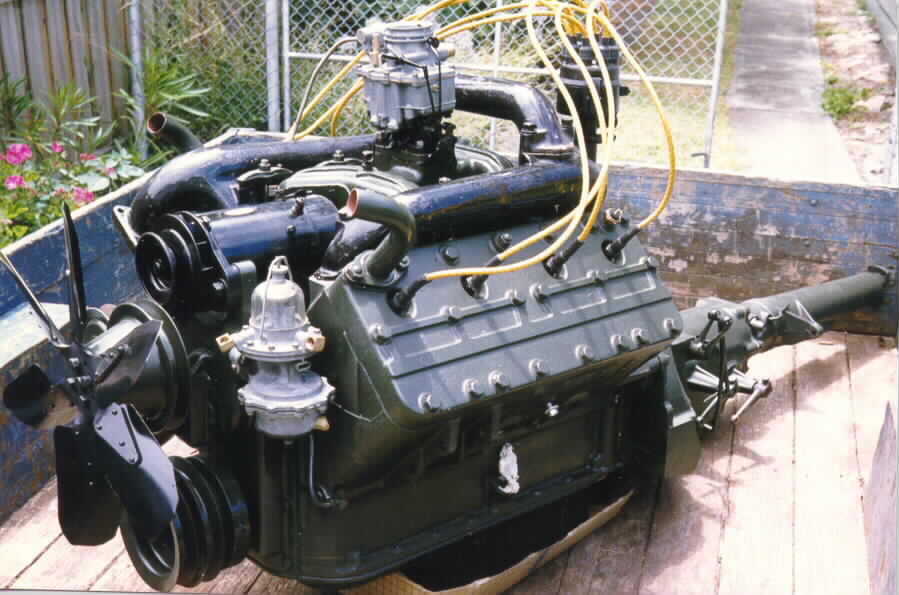

The Flathead Cadillac. People usually think you've made a mistake when you tell them that Cadillac offered a V8 engine as early as 1915. We readily accept that any fifties, sixties or seventies Cadillac will have a blue painted V8 under its bonnet, but what did older Cadillacs have? Wasn't it an old side-valve? Yes it was a side-valve or valve-in-block, or L-head V8, a type commonly known as a "flathead".
Cadillac V8 engines from 1915 to 1935 consisted of a large alloy crankcase with cast iron cylinder blocks bolted to it. The blocks were not staggered, so fork-and-blade connecting rods were used to allow the con-rods to operate directly opposite each other. The engine was complex, expensive to build, and heavy considering its alloy crankcase.
Cadillac's monobloc V8 was introduced in 1936, combining the crankcase and blocks in one large (and still heavy) iron casting. The precision casting was quite an achievement at that time, as the people in Henry Ford's foundry would testify during the trouble-prone introduction of Ford's new V8 a few years earlier where the rejection rate of block castings reached 80%.
At this time, Cadillac was building V-12 and V-16 engines as well as V8s and a straight-eight, and management was seeking to rationalise the wide range of engines to reduce costs. It was no accident that performance of the 1936 V8 equalled that of the mighty but expensive sixteen.
The 1936 Cadillac V8 engine began at 322 cubic inches and 125 bhp @ 3400rpm, but the next year, several improvements were made and a 346 cubic inch version was installed under the bonnet of all Cadillacs until 1948. The 322 engine became the La Salle powerplant from 1937 onwards, and it was identical except for its slightly smaller bore. Typical of design thinking at that time, the stroke was greater than the bore (by 1.125 inches) giving very satisfying torque figures and wonderful top-gear performance from 5 mph to 100 mph.
Australian mechanics and handymen who have knocked around old engines for years are familiar with the Ford flathead V8; so familiar is the Ford in fact that many people believe that Ford invented the V8 concept and were the only maker to use it until Chevrolet "followed suit" in 1955. These people are shocked to learn that GM had designed and marketed four production V8 engines before Ford's big gamble in 1932. A glance is all it takes to pick a Cadillac from a Ford V8 - the Cadillac's exhaust manifolds are mounted high up above the engine's valley to avoid passing hot exhaust gases through the water jacketting like Ford did. The Cadillac's block is also visibly larger than any Ford engine.
Another way you could tell was to select a gear - any gear - and accelerate. The Cadillac could out-accelerate and outrun almost any American car, and it could make the performance of the highly-touted Ford V-8 look asthmatic. The Cadillac's smoothness was as uncanny as its seemingly endless speed. Most flathead engines idle quietly enough to bring a smile to the face of any old-time mechanic, but the side-valve Cadillac was built with unmatched quality and care, and it was the first car to use modern hydraulic valve lifters set down inside the block. Those engines were SILENT. In fact, longtime NSW Club member Bill Spraggon used to say of his '39 Cadillac that you had to stick your finger into the fan to see if the engine was running.
Of course, these engines made lots of horsepower and torque. The first 346 gave 135 bhp @ 3400 and 250 ft/lbs at 1700 rpm, while the last flathead in 1948 gave 150 bhp at 3800, and 283 ft/lbs at just 1600.
When war came again (1941 in America) an urgent supply of rugged powerful adaptable engines was suddenly needed to power tanks, boats, generators, etc. The Cadillac was supplied in huge numbers, and built an enormous reputation around the world. Many of these 1941 engines ended up in Australia, and brand new ones still turn up occasionally.
In automotive use, the engine has remained popular with restorers. This powerplant will propel any Cadillac at today's highway speeds, and will surprise many new-car drivers at the stop light. Its appetite for fuel is to be expected, but perhaps its only vice is its hot running.
Period Cadillac service literature devotes enough space to remedying overheating and vapor-locking to indicate that these engines can run hot. On today's fuel and in today's traffic you will probably experience fuel or temperature problems when driving your flathead Cadillac. Overheating can be fixed by thoroughly cleaning the block's water passages at rebuild time. I believe that most overheating Cadillacs in Australia are using military blocks whose water passages are full of rust of scale, and whose radiators need rodding out or replacement to restore water flow. I also believe that the original thermostat (in the radiator with shutters until '41, conventional bellows from '42) is essential in minimising hot running. Vapourising or vapour locking can be controlled by use of an electric fuel pump - these cars were not intended to sit idling at four-stage traffic-light intersections, and 900 pounds of cast iron throws out lots of heat. 6-volt starting when hot has also copped some bad press, but again if the cables are heavy, the starter motor rebuilt and the earths are good, the flathead will restart every time.
You think I like this engine? You're right.
Peter Ratcliff
